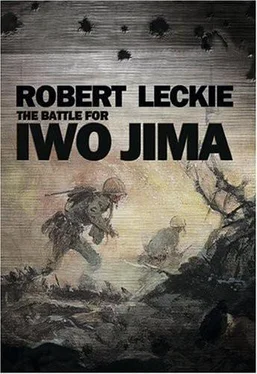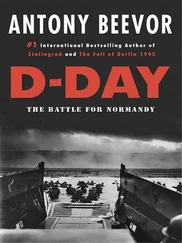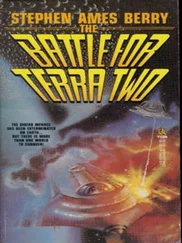With that, the replacements entered their baptism of fire. Once they had survived a day or two of it, however, they came to be regarded as “good Marines” and were accepted into their squads with all the comradeship accorded any “original.” Actually, on Iwo Jima it was a rare squad that survived with most of its originals. By the time the battle was over, the “boot” replacements had become the “old salts.”
As the replacements went into line on February 25, the seventh day of battle, the last of the reserve was also committed. These men were the 9 Marines of the 3 Division. The 9 relieved the 21 in the center. It moved through the small hole punched in the enemy line by Archambault’s men, and went slugging with an agonizing slowness toward Hill 199.
This hill was vital. It commanded Airfield Number Two. And the enemy there held out for three days. A major factor in the capture of the hill was the one-man battle fought by Private First Class Wilson Watson. After destroying a pillbox single-handed, Watson climbed a ridge and stood boldly outlined against the sky while killing 60 Japanese with his automatic rifle. He came down only after he ran out of ammunition, and many Marines believed that it was a miracle that Wilson Watson lived to receive his Medal of Honor.
When Hill 199 passed into American hands on February 27, the uneven Marine line was at last straightened out. All but a few yards of Airfield Number Two had been captured and roughly one third of Iwo Jima was not conquered. Some 50,000 Americans were ashore and 2,000 of them were Seabees already at work expanding and improving Airfield Number One. Beneath the rising and falling roar of battle there now ran the steady growling of the bulldozers. Not all of them, of course, were at work on the airfields.
Some of them were building cemeteries.
Chapter 6
INTO THE MEATGRINDER
On February 25, two days before the fall of Hill 199, the American attack on both flanks had begun to grind down to a bloody crawl. On the west coast, the 5 Division had come up against a system of fortified ridges crowned by the bastion known as Hill 362A. On the east coast the 4 had entered the “Meatgrinder.”
The Meatgrinder was the name which the Marines had given to a defensive system lying roughly half-way up the island, just east of airfield Number Two. Here they were quite literally torn apart on the Meatgrinder’s three cruel blades. These were Hill 382, the highest ground on northern Iwo; a little bald hill known as Turkey Knob; and a rocky bowl called the Amphitheater. Within this complex lay the Japanese communications system. Here, unseen among a network of caves and tunnels, the Japanese had kept the Marines under observation since D day.
The approach to the Meatgrinder offered no concealment. Bombardment from every quarter had stripped the area of its oak trees and laid bare a maze of rocks and brush criscrossed by defiles running to the sea. All the approaches were covered by tanks buried up to their gun turrets. Behind them, cleverly concealed or out of sight in the caves, were machine guns and mortars, antitank guns, and light artillery and antiaircraft guns depressed to fire point-blank. Hill 382, Turkey Knob and the Amphitheater were also mutually supporting. They could defend themselves or one another. It was not possible to take the Meatgrinder point by point, but only by laying all three points under attack at once.
The 4 Marine Division began its assault with a furious bombardment. Land artillery thundered, naval gunfire bellowed, mortar boats and landing ships ran in close to the shoreline to fire up the defiles. While bobbing amtanks put the coastal flank under fire, carrier aircraft came screaming down through the smoke and dust to strafe and bomb. As the bombardment rose in fury, the 4 tried to get around to the enemy’s rear by sending its tanks on a sweep through the 3 Division’s area. Meanwhile, armored tankdozers butted paths through a rubble of smashed rocks.
Then the foot troops attacked. At first, the Marines went up Hill 382 with surprising ease. But once they reached the summit, the enemy recovered from the shock of the bombardment and opened fire. The Marines were pinned to the ground. They were even struck from the rear, where they had unknowingly passed a hidden system of pillboxes. Under cover of a smoke screen, the Marines came down from Hill 382. The day’s gains were 100 yards, or “one touchdown,” as Major Frank Garretson would say. This former football star was fond of measuring advances on Iwo in terms of 100-yard “touchdowns.”
With the close of battle that night, the Marines held about two-fifths of Iwo Jima and had suffered 8,000 casualties since landing. In Japan, a jubilant but not exactly truthful Radio Tokyo broadcast reports of wholesale slaughter of the Americans. The enemy’s hold on Iwo Jima, the broadcast declared, was “not more than the size of the forehead of a cat.” Many Marines in front of Hill 382 would have agreed with that estimate, at least as far as their own area was concerned. They did not realize that they were assaulting the eastern half of General Kuribayashi’s main line of defense. Even a gain of “one touchdown” was more than the Japanese commander was willing to surrender.
A touchdown was about all the Marines got on the following day, February 26. But they did knock out the pillbox positions they had by-passed. This was done by Private First Class Douglas Jacobson, a rifleman. As he started toward Hill 382 again that day, he saw an American bazooka man go down. Jacobson dropped his rifle and seized the bazooka. Running from position to position like a man berserk, he destroyed 16 pillboxes, knocked out a tank and killed 75 Japanese soldiers. Much of his regiment’s advance that day was due to Jacobson, who received a Medal of Honor for his valor. Yet the Marines had to withdraw for the night.
The same sort of thing was happening at Turkey Knob and the Amphitheater. Every time the Marines drove deep into the enemy defenses, they were made to pay dearly for it. The Japanese simply pulled back and called down the mortar and artillery fire which had been “zeroed-in” on their own positions. After the Americans were forced out at dusk, the Japanese returned to prepare a bloody encore for the following day.
For one full week—from February 25 to March 3—the 4 Marine Division was ground to a bloody pulp in the Meatgrinder. Casualties rose at such an alarming rate that the 4 used 400 pints of fresh blood on a single day. Yet each day’s assault left Kuribayashi’s eastern anchor weaker and weaker. General Cates fed more and more fresh units into the battle. One by one, the Japanese positions were blasted to rubble or sealed off.
At Turkey Knob a 75-millimeter howitzer was dragged over rock and rubble to deliver point-blank fire at a blockhouse that was the center of the height’s defenses. Under covering rifle fire, demolition men crawled up to the blockhouse walls. They planted their charges to tear gaping holes in the walls. Then tankdozers cut a path through the rubble for a flamethrowing tank. Rumbling forward with its flame thrower hissing, the tank poured streams of flame through the holes. Still the blockhouse held out. So did Turkey Knob, so did the Amphitheater, so did Hill 382.
On Friday, March 2, after six days of assault on the Meatgrinder, the 4 Marine Division hit this wicked trio with all its strength. Turkey Knob and the Amphitheater were each attacked by a regiment. The objective was to prevent these strongpoints from firing on the force attacking Hill 382. In this, the Marines were successful.
Company E, under Major Rolo and Carey, and Company F, under Captain Walter Ridlon, prepared to move out against Hill 382. Before they did, heavy artillery laid down a barrage. Supporting fire from tanks and whooshing flights of missiles launched by rocket trucks also helped. Major Carey’s men attacked on the left, Captain Ridlon’s on the right. By mid-morning one of Carey’s platoons was just under the smashed radar antenna, which was situated atop the hill.
Читать дальше











